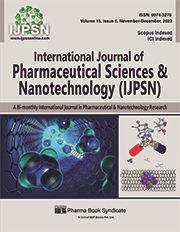Formulation and evaluation of cost effective herbal sunscreen gel from aqueous extracts of different fruits of Mizoram, India
DOI:
https://doi.org/10.37285/ijpsn.2022.15.6.5Abstract
Background: Herbal cosmetics have been in tremendous demand in the market due to their unique properties and minimal side effects. The popularity of herbal cosmetics is mainly due to the effect produced by the herbal extract used and its inherent suitability for routine use in daily life. Herbal cosmetics also avoid adverse effects compared to synthetic products.
Herbal extracts show remarkable photo protection owing to their ability to absorb ultraviolet (UV) rays, and antioxidant, anti-inflammatory, and immunomodulatory properties. Moreover, herbal cosmetics offer the means of less costly products compared to synthetic ones. Therefore, the aim of the present study was to formulate and evaluate cost-effective herbal sunscreen gel containing aqueous fruit extract of Emblica Officinalis (Indian gooseberry) belonging to the family Euphorbiaceae, Daucus carota (Carrot), family- Apiaceae, Carica papaya (Papaya), family-Caricaceae, Punica granatum (pomegranate), family-Punicaceae and latex of leaves of Aloe barbadensis, family-Liliaceae.
Methods: The fruits were grinded with a mixer grinder, extracted with distilled water, and then filtered. The Sun protection factor (SPF) of the extracts was determined using a UV visible spectrophotometer followed by different formulations (F1, F2, F3) of sunscreen gel.
Results: The SPF value of the herbal extract of Indian gooseberry, Carrot, Aloe Vera, Papaya, and Pomegranate were found to be 0.779±0.616, 2.527±2.213, 0.349±0.318, 2.794±2.976, 2.468±2.313 respectively. The SPF values of formulated gel F1, F2, and F3 are 5.293 ± 0.680, 3.537 ± 0.494, and 3.914± 0.501 respectively. Among the formulations, F1 showed the highest SPF value and better physicochemical properties. After accelerated stability studies, formulated sunscreen did not loss its potency.
Conclusions: We can conclude that formulated herbal sunscreen gel may protect skin from harmful UV radiation and can be used as an alternative source of cost-effective sunscreen formulations.
Downloads
Metrics
Keywords:
Herbal gel, Herbal sunscreen gel, Sun Protection Factor (SPF), UV-protection, Cost-effective sunscreenDownloads
Published
How to Cite
Issue
Section
References
Das S, Haldar PK, Pramanik G. Formulation and evaluation of herbal gel containing Clerodendron infortunatum leaves extract. International Journal of PharmTech Research. 2011;3(1):140-143.
Debbarma A, Roy PK, Barbhuiya SB, Das J, Lalhlenmawia H. Bioactive Compound and Nanotechnology: A Novel Delivery Perspective for Diabetic Retinopathy. Current Bioactive Compounds. 2021 Oct 1;17(8):2-14.
Dutra EA, Oliveira DA, Kedor-Hackmann ER, Santoro MI. Determination of sun protection factor (SPF) of sunscreens by ultraviolet spectrophotometry. Revista Brasileira de Ciências Farmacêuticas. 2004;40:381-5.
Garg U, Jain K. Dermal and Transdermal Drug Delivery through Vesicles and Particles: Preparation and Applications. Advanced Pharmaceutical Bulletin. 2022 Jan;12(1):45.
Jangde R, Daharwal SJ. Herbal sunscreen: An overview. Research Journal of Topical and Cosmetic Sciences. 2011;2(2):35-9.
Madaan R, Bala R, Verma A, Sarma R.Determination of Sunscreen activity of Viola odorata (Banafsha) ethanolic extract and its formulated Gel by UV Spectroscopy." International Journal of Research in Pharmaceutical Sciences,2011;11(1): 154-159.
Malsawmtluangi C, Nath DK, Jamatia I, Zarzoliana E, Pachuau L. Determination of Sun Protection Factor (SPF) number of some aqueous herbal extracts. Journal of Applied Pharmaceutical Science, 2013; 3(09): 150-151.
Mbanga L, Mpiana PT, Mumbwa AM, Bokolo K, Mvingu K, Ngoy B, Muwawa K, Mulenga M. Sun protection factor (SPF) determination of cosmetic formulations made in kinshasa (DR Congo) by In-Vitro method using UV-VIS spectrophotometer. Democratic Republic of Congo: Département de chimie, Faculté des Sciences Université de Kinshasa. 2014.
Mishra AK, Mishra A, Chattopadhyay P. Assessment of in vitro sun protection factor of Calendula officinalis L.(asteraceae) essential oil formulation. Journal of Young Pharmacists. 2012 Jan 1;4(1):17-21.
Ngoc LT, Tran VV, Moon JY, Chae M, Park D, Lee YC. Recent trends of sunscreen cosmetic: an update review. Cosmetics. 2019 Nov 1;6(4):64.
Nohynek GJ, Schaefer H. Benefit and risk of organic ultraviolet filters. Regulatory Toxicology and Pharmacology. 2001 Jun 1;33(3):285-299.
Pachuau L, Roy PK, Zothantluanga JH, Ray S, Das S. Encapsulation of Bioactive Compound and Its Therapeutic Potential. InBioactive Natural Products for Pharmaceutical Applications 2021 (pp. 687-714). Springer, Cham.
Patekar RR, Choudhary HB, Rede SD. Formulation and Evaluation of Ethosomal Gel and Non-ethosomal Gel of S. grandiflora Leaves. Research Journal of Pharmacy and Technology. 2022 Mar 1;15(3):1029-36.
Patel NA, Patel NJ, Patel RP. Comparative development and evaluation of topical gel and cream formulations of psoralen. Drug Discoveries & Therapeutics. 2009 Oct 1;3(5).






